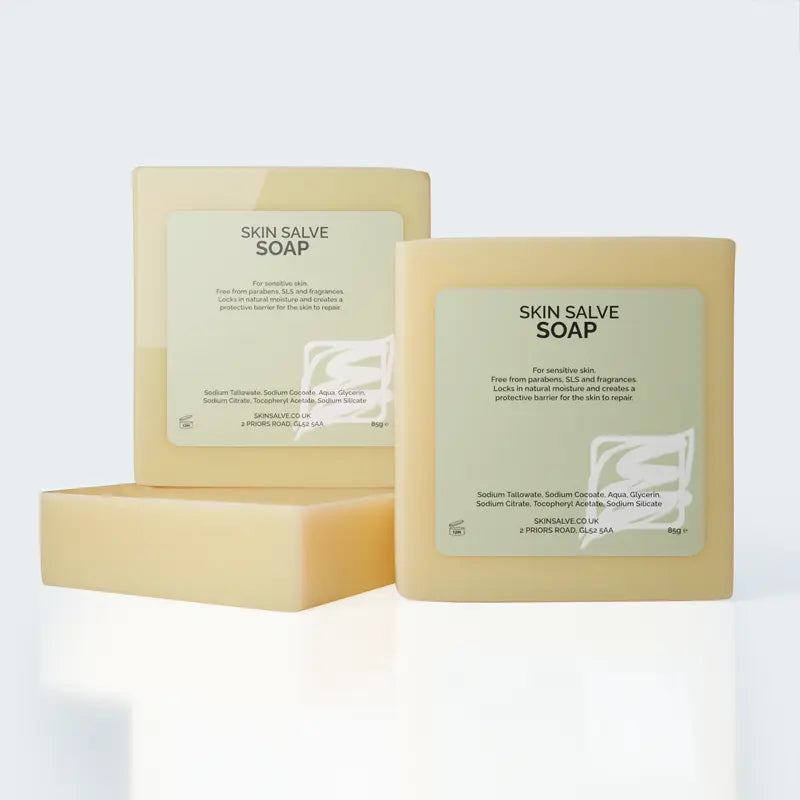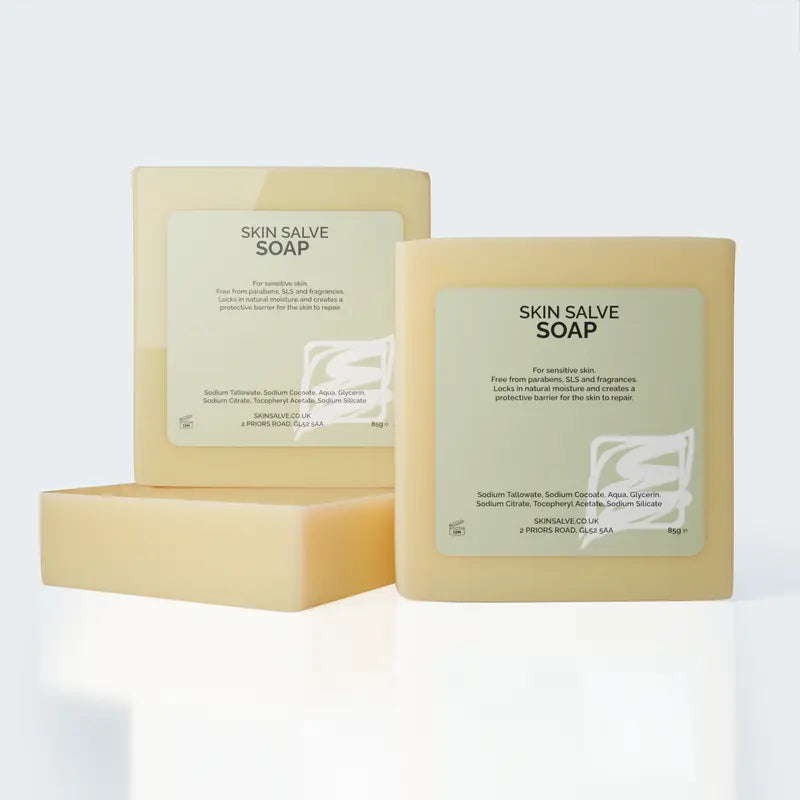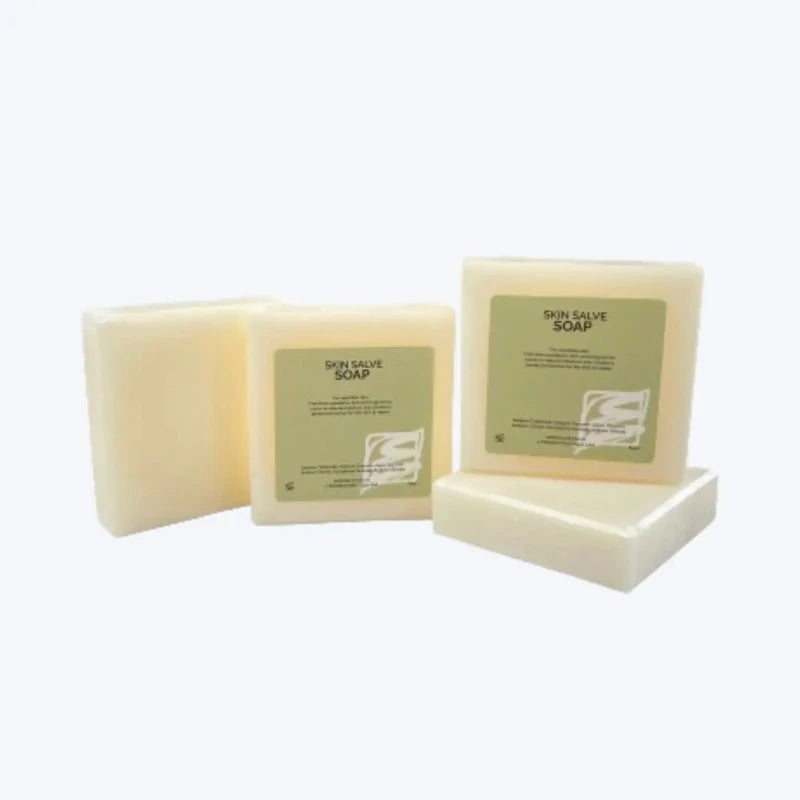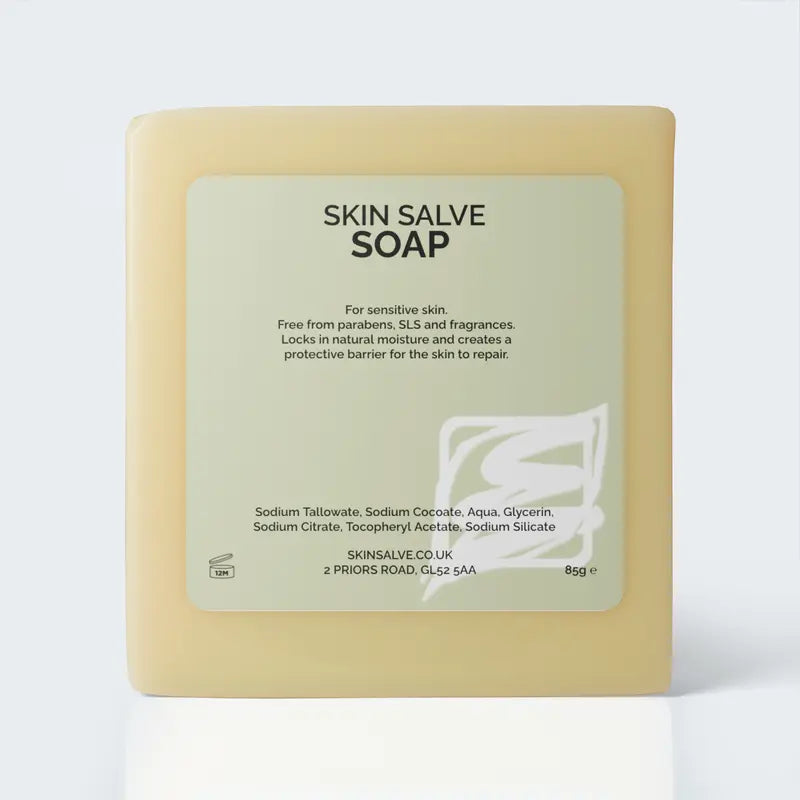Skin Salve Natural Soap has been helping people for over 30 years. Below explains why, but if you need a short summary:
- Natural ingredients that are free from irritants, parabens and avoids unnecessary ingredients that may harm sensitive skin
- A soap making process that allows us to control everything to make the perfect bar
The Natural Ingredients in Our Soap
If you read the label of most soap bars you’ll see anywhere from 10 to 20 ingredients. Some will include fragrances, some will include chemicals and colourants, others will include fillers and irritants like Parabens, Sodium Lauryl Sulfate (SLS) and Sodium Laureth Sulfate (SLES). These ingredients are cheap ways to make soap that isn’t always good for your skin.
Skin Salve Natural Soap has just seven ingredients (six if you exclude water).
Click on each ingredient below to see how they help your skin and mean that Skin Salve Natural all over your body, including as a shaving soap.
Sodium Tallowate
Because of its cleaning and moisturising characteristics, Sodium Tallowate has long been used in soap production to produce bars that are great for the skin.
Sodium Cocoate
Sodium Cocoate is derived from Coconut oil. It acts as a surfactant, or a surface-active substance that helps get rid of dirt, oil and other pollutants while moisturising the skin.
Glycerin
Glycerin benefits the skin barrier by pulling water from the air to keep the skin hydrated and minimise water loss.
Tocopheryl Acetate
Known as tocopherol or Vitamin E, it is considered an anti-inflammatory agent in the skin. It’s also extremely hydrating – it’s both a ‘humectant’ and an ‘emollient’ – so it helps your skin absorb water and traps it within the skin too. And it’s been shown to help relieve eczema for some people. It's common in many anti-ageing creams, eye serums, sunscreens, and makeup.
Sodium Silicate
Sodium Silicate has been used in cosmetics for years as it helps improve the appearance of skin.
Unscented and irritant-free soap
Skin Salve Soap is unscented to avoid including any unnecessary chemicals. It doesn’t make sense to us to add in extra chemicals so that the bar smells, only for you to wash that scent off the moment you use it. If you find that normal soap leaves a scent on your skin, you can be confident it’s leaving chemicals there, too.
Natural ingredients to produce a natural soap bar
Making soap is a relatively simple process - you combine oils with lye. This process creates saponification which converts the oils into soap.
In Cold Process Soap, the process is effectively the same for any kind of oil and ingredients (there are some differences in temperature). What is important is the ratios of oils, lye and any other ingredients.
Great soap is judged against the following criteria:
- Hardness
- Cleansing
- Conditioning
- Bubbly lather
- Creamy lather
The perfect soap would score exceptionally in all categories. But each core ingredient has trade offs. For example, a bar that is extremely ‘cleansing’ is often not very ‘conditioning’.
To make great soap, you need to balance your ingredients to deliver the optimum against each criteria.
Skin Salve Natural Soap does this:
|
Quality |
Range |
Skin Salve Soap |
|
Hardness |
29 to 54 |
60+ |
|
Cleansing |
12 to 22 |
20+ |
|
Conditioning |
34 to 69 |
35+ |
|
Bubbly Lather |
14 to 46 |
20+ |
|
Creamy Lather |
16 to 48 |
40+ |
Saponification data from https://www.modernsoapmaking.com/blog/soapcalcs-soap-quality-numbers and http://soapcalc.net/calc/soapcalcwp.asp
The ingredients in Skin Salve Soap mean each bar is high in skin-protecting Fatty Acids:
Lauric
Full of antibacterial and anti-inflammatory actions, Lauric acid is a fatty acid found in coconut and is used for its skin repairing, anti-acne, detergent and cleansing properties. [1]
Myristic
Myristic acid is backed with powerful cleansing and surfactant properties, which makes it a perfect ingredient for cleansing products. In addition, it aids in removing dirt, excess oil, and impurities. This results in the skin appearing clear, soft, and supple.[2]
Palmitic
Acts as an emollient and helps the skin retain moisture by forming an oily, water blocking layer that slows the loss of water through the skin. [3]
Stearic
An emollient that is effective in moisturising and hydrating the skin. It protects the skin by forming a moisture barrier from moisture loss and keeps it hydrated for longer. It is especially beneficial for people with dry skin, as it effectively retains the skin's natural moisture. [4]
Oleic
Is used to hydrate and lock in moisture, making it particularly attractive for skin treatments such as protective creams or toners. This also makes it a great choice for hair care products. [5]
Linoleic
Also known as Vitamin F, provides moisture to the skin. It fortifies and protects the skin's barrier, helping to fend off UV rays and air pollutants such as smoke. [6]
Linolenic
Is a skin conditioning agent and skin restorative ingredient. Research demonstrates it has anti-inflammatory properties as well. [7]




